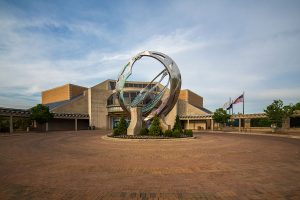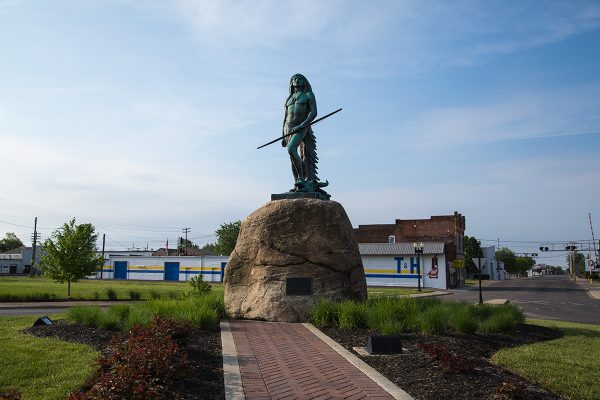 Passing of the Buffalo - Muncie
Passing of the Buffalo - Muncie
Many communities in Indiana - both large and small - have commissioned public artworks to beautify their communities over the past two-hundred years. Muncie, for example, has a long history of installing public art, going all the way back to the Indiana Gas Boom. Commissioned by wealthy industrialists, religious organizations, government entities, and nonprofit organizations - public art was thought to inspire residents and celebrate the unique culture of east-central Indiana.
In 2013, I had the privilege of photographing Muncie's public art for the Muncie Arts and Culture Council. Although new artwork has been added in the past four years, about one-hundred exterior and interior pieces are found throughout the city including: sculptures, historic objects/artifacts, religious statues, war memorials, abstract installations, and other pieces designed for the public. Some of the artwork is elegant as defined by classical artistic sensibilities, while a few pieces are probably best described as pop art.
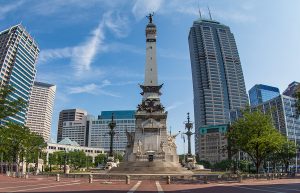 Soldiers' and Sailors' Monument - Indianapolis
Soldiers' and Sailors' Monument - Indianapolis
In Muncie, like many other Indiana cities, public artwork has become a critical component of community development for several reasons. First, public artwork, along with architecture, assists in providing iconic structures to help shape the cultural identity of a community - think of the Soldier's and Sailor's Monument in Indianapolis. Second, public works of art connect residents together, while beautifying their public space, or commemorating historical events. Examples of this exist all over Indiana - think of the numerous artworks that adorn the lawns of so many courthouse squares. Third, public art demonstrates a community's commitment in seeing the arts thrive for its residents. The arts, of course, are a crucial component of quality of life initiatives as well as economic development drivers.
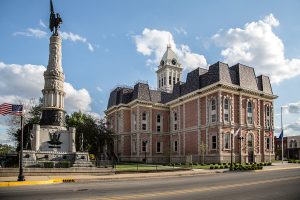 Randolph County Courthouse Square - Winchester
Randolph County Courthouse Square - Winchester
While beauty is ultimately in the eye of the beholder, I took the liberty of listing my favorite top-ten works of public art in my hometown of Muncie. In a few weeks, the weather will turn warm. For those in the east-central Indiana area, or if you are traveling through Muncie, I encourage you to take a long afternoon tour to see the works for yourself. For a full list of Muncie's public art, visit: http://munciearts.org/publicart/.
10. Paul Bunyan
 Paul Bunyon - Muncie/Timbers Lounge
Paul Bunyon - Muncie/Timbers Lounge
Undoubtedly in the category of pop art, the giant statue of Paul Bunyan starts my list at number 10. The giant fiberglass statue was installed in 1964 for the Kirby Wood Lumber Company at a different location. This work was completed by the artist Richard Kishel as an advertisement. Giant roadside statues such as this are often referred to as "Muffler Men" as they were typically found outside of auto mechanic shops in the 1950s. Paul Bunyan was moved in front of Timbers Lounge at the corner of Highway 32 and Tillotson in the 1990s.
9. Five Points Fountain
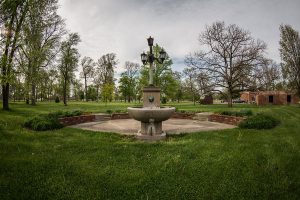 Five Points Fountain - Muncie/Heekin Park
Five Points Fountain - Muncie/Heekin Park
At the turn of the 20th century, the primary mode of in-town transportation was still the horse throughout much of the United States. The treatment of horses became an issue for the National Humane Alliance. The NHA's founder, Herman Lee Ensign, created the organization to foster ideas of humanity to the lower animals and each other. Upon his death, he donated money for many communities across the United States to install drinking fountains for horses. In 1911, thirty of these fountains were placed around the city of Muncie. One by one over the 20th century, they disappeared. The last fountain, at the "Five Points" intersection in Muncie was moved to Heekin Park in 1971 and rededicated to commemorate this legacy.
8. George McCulloch
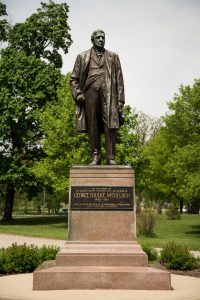 George McCulloch - Muncie/McCulloch Park
George McCulloch - Muncie/McCulloch Park
One early prominent figure in Muncie was George McCulloch, a Gas Boom era entrepreneur. McCulloch was an ambitious man and assisted in transforming Muncie from an agricultural backwater to a regional capital of the industrial era during the Gas Boom. He started the Enterprise Company in 1892 (manufacturing interest), was the treasurer of the interurban Union Traction Company, and was the founder of the Muncie Star Publishing Company. In 1901, he donated an enormous amount of land on the city's east side that became McCulloch Park. After McCulloch's death in 1915, the city commissioned the sculptor Leonard Crunelle to memorialize McCulloch with a life-size bronze casting. Completed and dedicated in 1917, McCulloch's statue has stood at the park's south end for 100 years.
7. Wait for Me
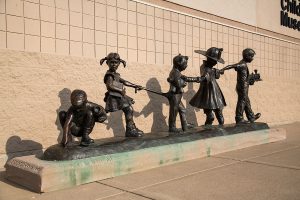 Wait For Me - Muncie/Children's Museum
Wait For Me - Muncie/Children's Museum
Dedicated in 1999, Wait for Me is a bronze sculpture that sits to the left of the Muncie Children's Museum entrance on High Street. Sculpted by the artist Paul Moore, the statue features five children walking toward the museum, each engaged in some whimsical activity.
6. First Symphony
 First Symphony - Muncie/Ball State University
First Symphony - Muncie/Ball State University
Numerous public art pieces exist throughout the campus of Ball State University. In 2004, Ball State opened the Music Instruction Building, with a new performance area - Sursa Hall. In 2008, the university commissioned the artist Stephen Knapp to install a lightpainting in the lobby. Completed in 2009, the 22' X 40' installation has enthralled Sursa Hall patrons for almost a decade. You need to be there in person to truly appreciate First Symphony, but this 3-minute overview video explains how the lightpainting works.
5. Catalyst
When the five Ball Brothers came to Muncie during the Gas Boom, each brother ended up building a home just north of the bend of the White River. Frank C. Ball's home, known as Minnetrista (gathering place by the water) was destroyed by fire in 1967. In 1988, the Minnetrista Cultural Center (now just Minnetrista) was built on the same site and offers elaborate gardens, cultural exhibits, an historical archive, and offers space for community engagement. In 2004, Virginia Ball commissioned the American artist Beverly Stucker Precious to install the Catalyst sculpture to commemorate her husband Edmund F. Ball (son of Edmund B. Ball - one of the five Ball Brothers). The limestone, steel, and glass sculpture sits at the front entrance of Minnetrista.
4. Bison-Tennial Public Art Project
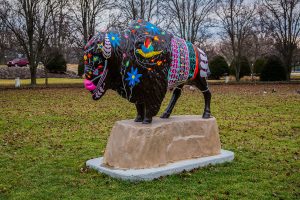 Bison-Tennial Bison - Muncie/Tuhey Park
Bison-Tennial Bison - Muncie/Tuhey Park
In 2016, Indiana celebrated the 200th anniversary of its statehood. As part of the celebration, the Indiana Association of United Ways launched a massive public art project - the Bison-Tennial Public Art Project. Throughout 2016, five-foot fiberglass bison were distributed to all 92 Indiana counties. Local artists were selected to paint designs on the bisons reflecting local history and culture. Muncie selected local artist Denise King to design the local bison. King utilized a Lenape Native American design (the Lenape founded Muncie) and the finished work was installed in Tuhey Park.
Why bison you say? Bison once roamed freely across Indiana before Euro-American settlement. Prior to 1800, it is estimated that 60,000,000 bison roamed most of North America. By 1900, massive hunting had reduced that number to just 300! Conservation efforts have assisted in restoring the population to about 360,000.
3. Passing of the Buffalo/Appeal to the Great Spirit
 Appeal to the Great Spirit - Muncie
Appeal to the Great Spirit - Muncie
I'm cheating here a bit, but two related sculptures tie at number three - Passing of the Buffalo and Appeal to the Great Spirit. I lump them together because they are related for several reasons: location, artist, and purpose.
In 1929, Muncie's Appeal to the Great Spirit was dedicated to the memory of Edmund B. Ball (one of the five Ball Brothers) by his family. The bronze statue was a smaller replica of a 1909 statue by Cyrus Dallin. Contrary to local legend, the statue does NOT feature a Lenape/Delaware Native American chief named Munsee. Dallin sculpted the original in 1909 to honor Ute Native Americans in his home state of Utah. The original bronze sculpture sits at the front entrance of the Boston Museum of Fine Arts. Forty smaller versions exist throughout the United States, one of which rests in a small park north of downtown Muncie along Walnut Street. The statue has become the de facto symbol for Muncie.
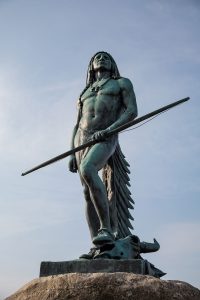 Passing of the Buffalo - Muncie
Passing of the Buffalo - Muncie
Passing of the Buffalo, another Cyrus Dallin statue, sits at the other end of downtown Muncie, at the Walnut Street roundabout. Purchased by Edmund F. Petty to honor his father Fred Petty, the bronze 1929 Dallin statue was originally commissioned by Geraldine Rockefeller Dodge. Edmund F. Petty was the son of Fred Petty and Margaret Ball Petty, and the grandson of Frank C. Ball - one of the five Ball Brothers. Edmund Petty purchased the statue from Dodge's estate and originally had it in front of the Ball Stores at the corner of Walnut and Charles streets. In 1976, the statue was donated to the city of Muncie. By 2007, the city installed the statue at the Walnut Street roundabout, just south of downtown.
2. Beneficence
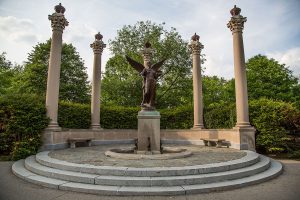 Beneficence - Muncie/Ball State University
Beneficence - Muncie/Ball State University
Although it has become the symbol and logo for Ball State University, the Beneficence statue was originally commissioned in 1927 by the Muncie Chamber of Commerce to honor the philanthropic activities of the five Ball Brothers - George, Lucius, Frank, Edmund, and William. The Muncie Chamber commissioned the work from Daniel Chester French in 1930. French is probably most known for sculpting the statue of Lincoln at the Lincoln Memorial in Washington. While the original Beneficence sculpture was completed in 1930 (Chester died a year later), the Great Depression prevented the Muncie Chamber from finishing the monument and dedicating the statue. Throughout the 1930s, enough money was raised - mostly from individual donors - to have the full monument, statue, and five columns installed and dedicated in 1937. As Ball State grew in size, the memorial to the beneficence (which means the ethical principle of doing good and providing charity) became the icon and logo for the university.
1. Extess
 Extess - Muncie/Cornerstone Park
Extess - Muncie/Cornerstone Park
Extess is the newest and perhaps most colorful public art installation in Muncie. Dedicated in the new Cornerstone Park at the corner of Main and Madison streets, Extess was commissioned by the City of Muncie from PROJECTiONE - a local fabrication company. Made from aluminum, the artists' design of Extess is computationally driven by delaunay triangulation, which is a relationship of a set of points to its closest neighbors. This algorithm seemed a fitting way to visually represent the interconnectivity of downtown.†As one drives or walks by the piece, the entire look and feel of the installation changes constantly.
For over 100 years, many civic and private individuals have worked hard to install public artwork in Muncie. The Muncie Arts and Culture Council works actively to preserve this legacy. MACC promotes the arts in Muncie specifically by creating, educating, advocating, nurturing, and inspiring the arts via civic initiatives and thorough engagement with individual arts and arts organizations. Both private and public officials are dedicated in seeing the arts thrive in Muncie, but also preserving the work already in existence.
The ten pieces here are of course, ranked based on the opinion of this author, but there is much more throughout the city. Before you plan your trip, visit the MACC's Public Art website.
